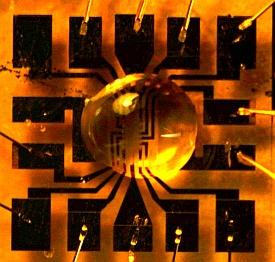

08/29/2011

From Ref. 1 © 2011 M. Kawasaki
Since the discovery of superconductivity more than a hundred years ago, new superconductors have typically been discovered by looking for new compounds that, when cooled to extremely low temperatures, show a vanishing electrical resistance. Masashi Kawasaki and colleagues from the WPI-AIMR in collaboration with researchers from the University of Tokyo have now devised an entirely new way of searching for superconductors — by artificially introducing large amounts of electrical charges into known materials1. Using the approach, the researchers have discovered superconductivity in the compound potassium tantalum oxide (KTaO3).
Superconductivity arises from a pairing of electrons in a material, which makes them immune to external disturbances such as scattering off atoms in the crystal. Given this key role of free electrons, many materials could be made to superconduct by introducing a surplus of free electrons by chemical ‘doping’. Unfortunately, however, there are constraints on the maximum charge that can be introduced in this way.
The alternative developed by Kawasaki and his co-workers is to introduce the electrons externally. This can be done through the use of an ionic liquid, which is able to transport large amounts of charge. By bringing the ionic liquid into contact with the surface of an electrical circuit containing the material (see image), an electric double layer is formed at the material–liquid interface. Applying an electrical voltage then separates the charges. On lowering the temperature, the researchers found that the compound, in this case KTaO3, transformed from its original insulating state into a semiconductor, a metallic conductor and eventually a superconductor.
“Through this ionic liquid-based method, we achieved a charge density in the material about ten times higher than that achievable by conventional methods,” says Kawasaki. Superconductivity had not previously been observed in KTaO3, and although the phenomenon was observed at very low temperature, the appearance of superconductivity is only possible because of the high electrical charge densities. The real potential of this new technique therefore lies in the discovery that superconductivity can be induced in materials under circumstances not investigated previously.
“We do not have the same limitations as with chemical doping. There are many compounds that could become superconducting by providing sufficient charge carriers but which have not been examined yet,” comments Kawasaki. In particular, while the discovery of superconductivity in KTaO3 is exciting in itself, the approach used to make the discovery is more exciting for its potential to uncover superconductivity at higher temperatures than achieved so far.
Ueno, K. Nakamura, S., Shimotani, H., Yuan, H. T., Kimura, N., Nojima, T., Aoki, H., Iwasa, Y. & Kawasaki, M. Discovery of superconductivity in KTaO3 by electrostatic carrier doping. Nature Nanotechnology 6, 408–412 (2011). | article
This research highlight has been approved by the authors of the original article and all information and data contained within has been provided by said authors.